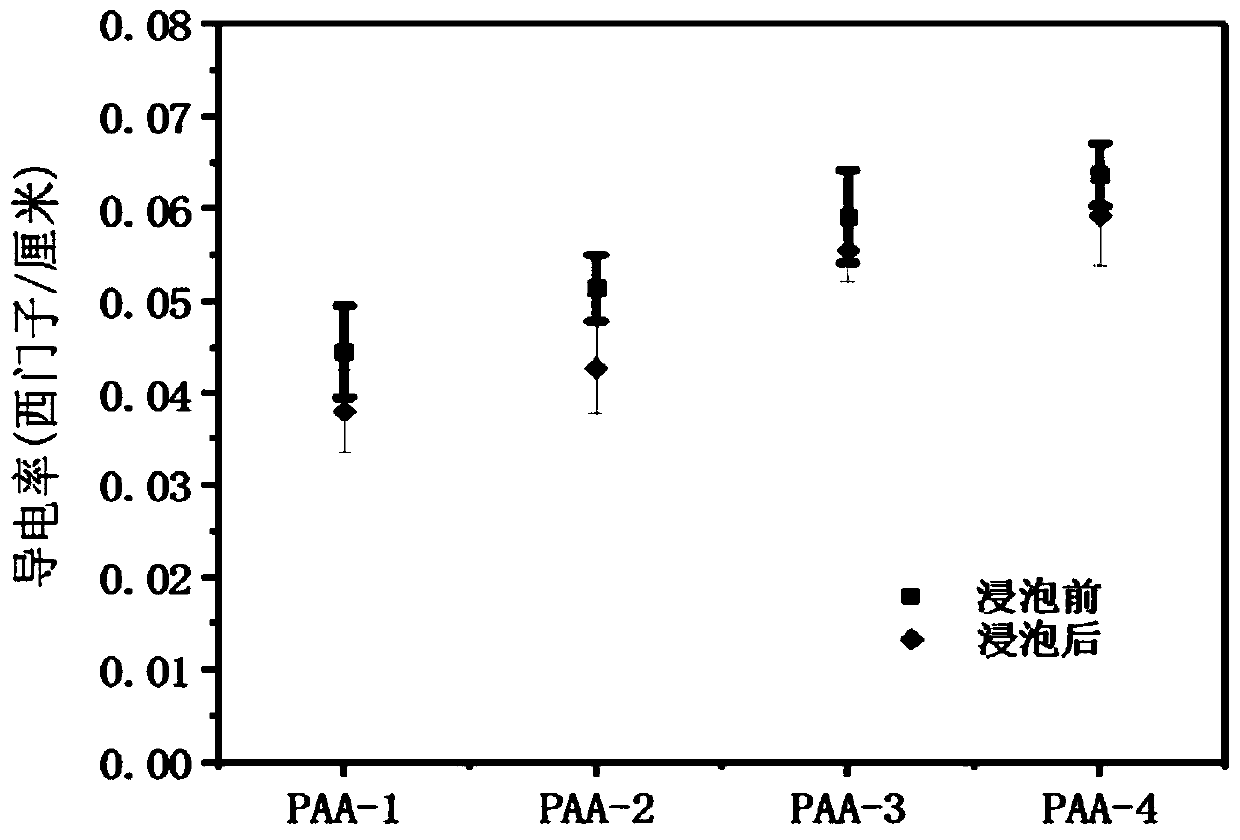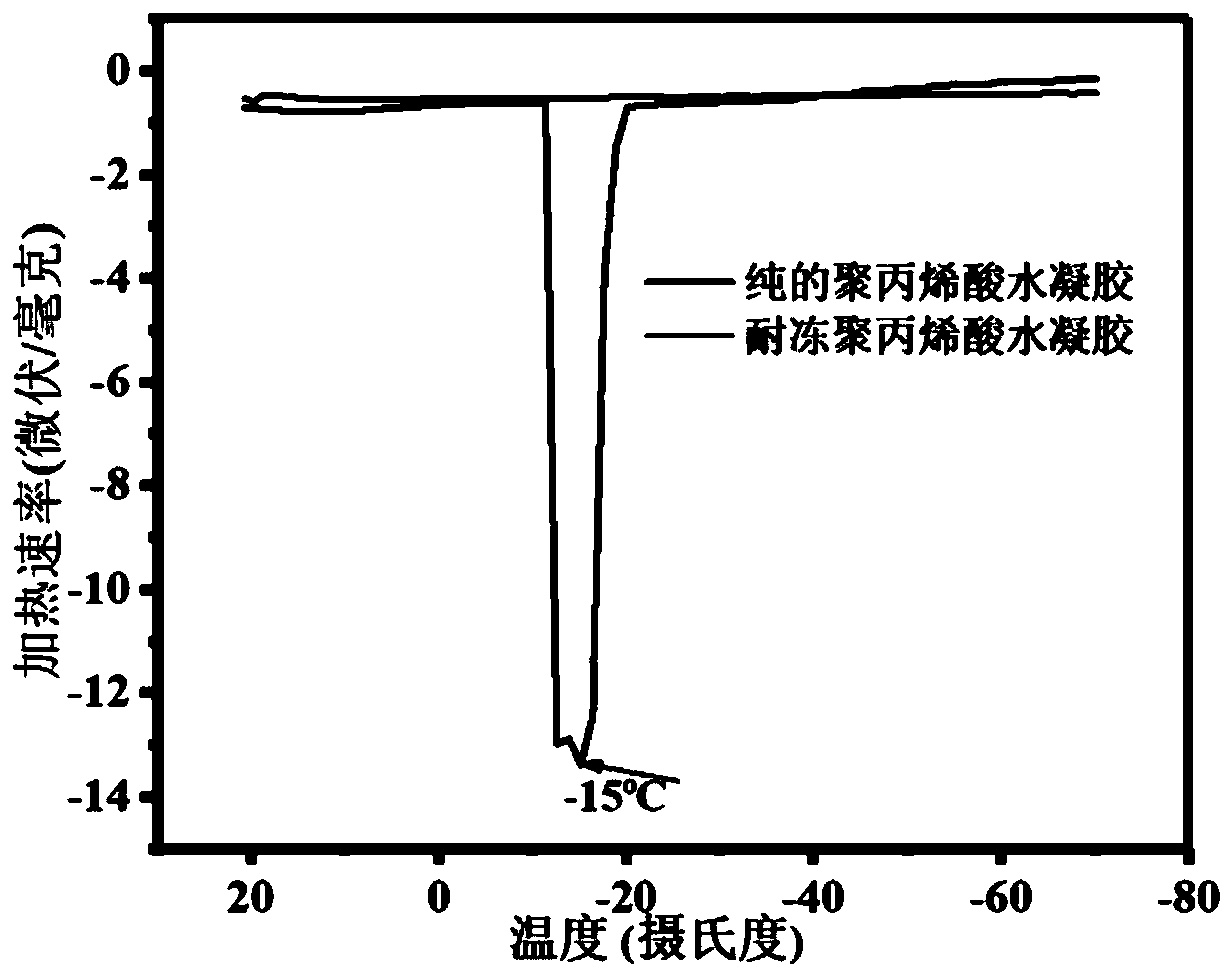Poly(3, 4-ethylenedioxythiophene) composite material and preparation method and application thereof
A technology of ethylenedioxythiophene and composite materials, applied in applications, medical science, sensors, etc., can solve the problems of inapplicable preparation of flexible electrodes, difficulty in antifreeze, adhesion, plasticity, biocompatibility, etc.
- Summary
- Abstract
- Description
- Claims
- Application Information
AI Technical Summary
Problems solved by technology
Method used
Image
Examples
preparation example Construction
[0030] The present invention relates to a kind of poly(3,4-ethylenedioxythiophene) / sulfonated lignin as conductive material super sticky antifreeze poly(3,4-ethylenedioxythiophene) / sulfonated lignin / A method for preparing a three-dimensional network hydrogel commercial electrode of polyacrylic acid, the steps of the method are as follows:
[0031] Step 1. Dissolve xg sulfonated lignin in water (solid content of lignin is 1%-5%), add 3,4 ethylenedioxythiophene and stir at 500r / min for 15 minutes, then add ammonium persulfate, pass through N 2 Reaction 24h.
[0032] Step 2: Add 0.05g of ammonium persulfate to 6g of acrylic acid, stir evenly with ultrasonic, add 50-1000ul poly(3,4-ethylenedioxythiophene) / sulfonated lignin dispersion obtained in step 1, add 10-30ml Water, after stirring, sonicate for 10-30min, then add 0.02g N, N methylenebisacrylamide, stir, sonicate for 10min, then heat in a water bath at 50°C for 2h to obtain a gel;
[0033] Step 3, take the gel obtained in ...
Embodiment 1
[0036] Step 1. Dissolve 1g of sulfonated lignin in 40.17ml of deionized water, add 0.50g of 3,4 ethylenedioxythiophene, stir at 500r / min for 20 minutes, add 1.003g of ammonium persulfate, and pass through N at room temperature 2 Reaction 24h.
[0037] Step 2: Add 0.05 g of ammonium persulfate to 6 g of acrylic acid, stir evenly with ultrasonic, add 100 ul of the poly(3,4-ethylenedioxythiophene) / sulfonated lignin dispersion obtained in Step 1, add 15 ml of water, and stir , sonicate for 10 minutes, then add 0.02g N, N methylenebisacrylamide and stir, then sonicate for 10 minutes, then heat in a water bath at 50°C for 2 hours to obtain a gel;
[0038] Step 3: Take the gel obtained in Step 2, soak it in glycerin for 2.5 hours, and take it out to obtain a three-dimensional network hydrogel of poly(3,4-ethylenedioxythiophene) / sulfonated lignin / polyacrylic acid.
Embodiment 2
[0040] Step 1. Dissolve xg sulfonated lignin in water (solid content of lignin is 2.0%), add 3,4 ethylenedioxythiophene and stir at 500r / min for 10 minutes, then add ammonium persulfate, pass N 2 Reaction 24h.
[0041] Step 2: Add 0.05g of ammonium persulfate to 6g of acrylic acid, stir evenly by ultrasonic, add 500ul of poly(3,4-ethylenedioxythiophene) / sulfonated lignin dispersion obtained in Step 1, add 25ml of water, and stir , sonicate for 10 minutes, then add 0.02g N, N methylenebisacrylamide and stir, then sonicate for 10 minutes, then heat in a water bath at 50°C for 2 hours to obtain a gel;
[0042] Step 3: Take the gel obtained in Step 2, soak it in glycerin for 3 hours, and take it out to obtain a three-dimensional network hydrogel of poly(3,4-ethylenedioxythiophene) / sulfonated lignin / polyacrylic acid.
PUM
 Login to View More
Login to View More Abstract
Description
Claims
Application Information
 Login to View More
Login to View More - R&D Engineer
- R&D Manager
- IP Professional
- Industry Leading Data Capabilities
- Powerful AI technology
- Patent DNA Extraction
Browse by: Latest US Patents, China's latest patents, Technical Efficacy Thesaurus, Application Domain, Technology Topic, Popular Technical Reports.
© 2024 PatSnap. All rights reserved.Legal|Privacy policy|Modern Slavery Act Transparency Statement|Sitemap|About US| Contact US: help@patsnap.com










